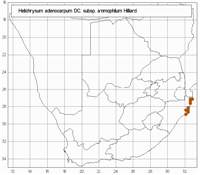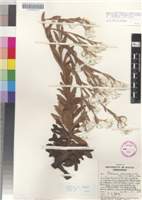Common names:
White everlasting, Wit sewejaartjie (A)
Origin of name:
aden = a gland + karpos / carpum = a fruit / fruits
adenocarpum = glandular fruits
ammophilus = sand-loving
Diagnostic characters:
Basal leaf rosette
Large heads in branched inflorescence
Bracts white
Description:
Perennial robust herb, stock woody, crowned with 1�several leaf rosettes, flowering stems lateral, decumbent or erect, to 1 m tall, simple or forking above into a few- to many-headed very open corymb, glandular-pubescent or woolly, closely leafy. Radical leaves sub-orbicular to elliptic-oblong, prostrate, 20�40 (�140) x 15�25 (�40) mm, mostly glandular-pubescent; cauline leaves oblong to lanceolate, smaller than the radical and passing into inflorescence bracts, cobwebby or glandular-pubescent. Heads heterogamous, campanulate, 15�20 mm long, c. 25�35 mm across the radiating bracts. Involucral bracts in 9�11 series, graded, loosely imbricate, much exceeding the flowers, glossy, acute, pure white. Flowers c. 165�520, 20�90 female, 145�500 homogamous, yellow often tipped red. Achenes 0,75 mm long, barrel-shaped, with myxogenic duplex hairs. Pappus bristles several, barbellate to subplumose in upper part, bases nude, not cohering.
Flowering between August and April.
Distribution:
In sandy, poorly drained grassland, often around the edges of marshy depressions. Recorded on the Tongaland plain, from Delagoa Bay and Inhaca Island in Mozambique to Lower Tugela district in KwaZulu-Natal.
Savanna Biome.
Notes:
Two subspecies are recognized:
Radical leaves cobwebby or woolly, involucral bracts ranging from crimson to scarlet or pink, or these colours on white, or rarely pure white and then growing with plants with parti-coloured bracts
(a) subsp. adenocarpum
Radical leaves glandular, very rarely cobwebby or woolly, involucral bracts always pure white
(b) subsp. ammophilum
subsp. ammophilum generally is a much more robust plant than subsp. adenocarpum with stems sometimes attaining a height of 1 m, many-headed corymbs, pure white involucral bracts, and at least the radical leaves without wool at maturity.
Taxonomy:
Literature:
Helichrysum adenocarpum DC. subsp. ammophilum Hilliard in Notes R. bot. Gdn Edinb. 32: 343 (1973), Compositae in Natal 240 (1977); DC.,Prodr. 6: 180 (1838); Harv. in F.C. 3: 229 (1865); Moeser in Bot. Jb. 44: 335 (1910); Batten & Bokelmann, Wild. Flow. E. Cape Prov. 156, plate 125,2 (1966); Compton, Fl. Swaziland 627 (1976).
Type:
KwaZulu-Natal, Ingwavuma distr., Ilala Flats past Mosi swamp on road to Maputa, 20 xii 1968, Pooley 268 (NU, holo.; E; NH, iso.).
Synonym(s):
Gnaphalium adenocarpum (DC.) Sch. Bip. in Bot. Ztg 3: 170 (1845).
Vouchers:
Moll 4716 (NU; PRE); Pooley 1712 (E; K; MO; NU; PRE; S); Strey 6803 (NU; PRE).

_sml.jpg)
_sml.jpg)
_sml.jpg)
_sml.jpg)
_sml.jpg)
